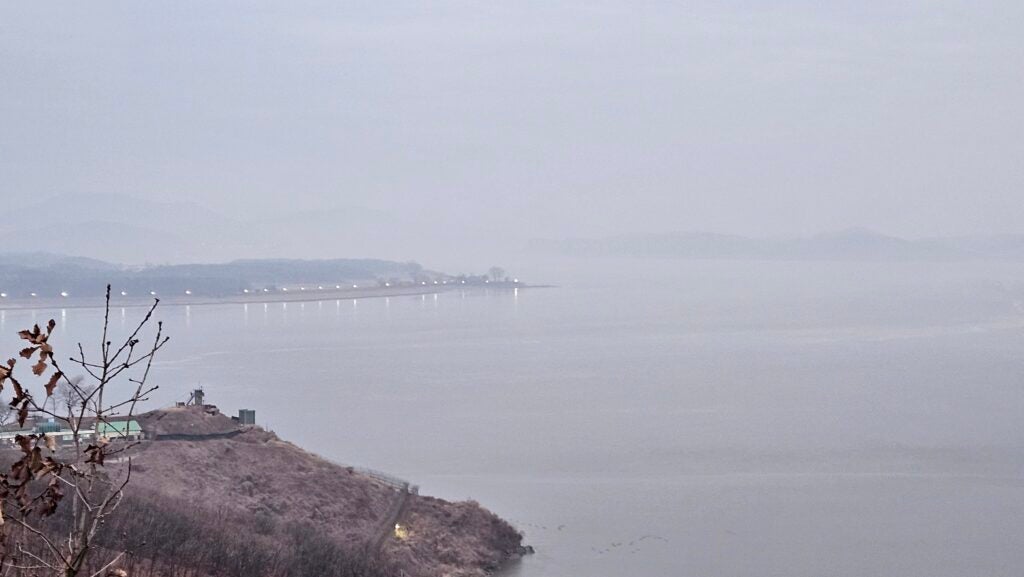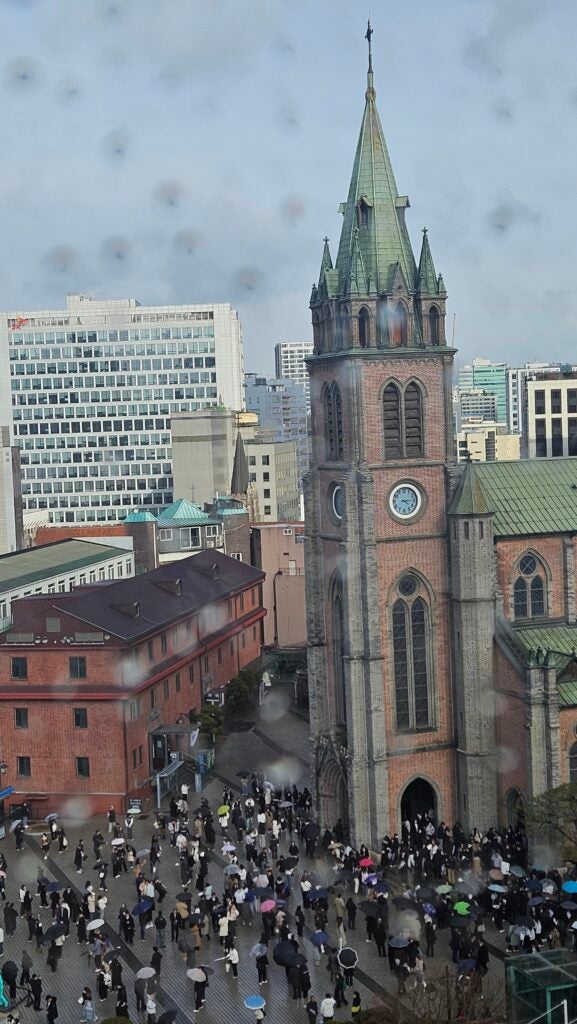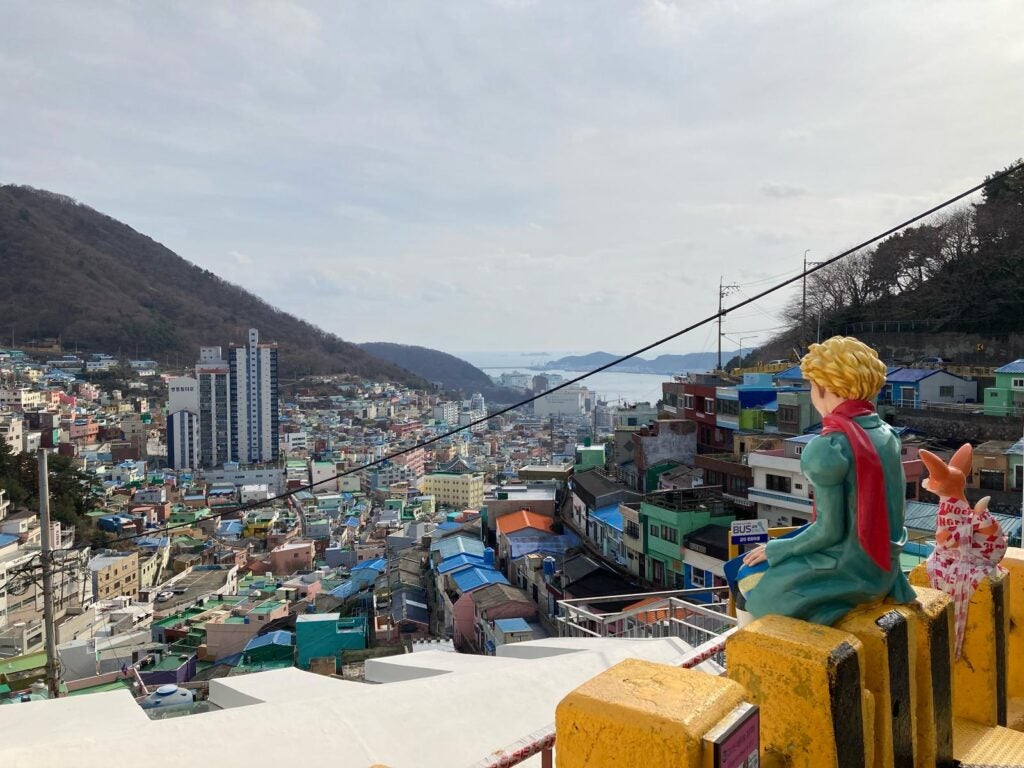Magis Immersion Seminar: Korean Catholics and the Interfaith Quest for Justice
A Photo Essay by Yajat Gupta (SFS’27)
One of the more unique ways that Georgetown University supports academic excellence, cura personalis, and holistic education is through the Magis Immersion Seminars. Each topic of the experiential learning opportunity includes rigorous in-class learning that explores the theological, historical, political, and other facets of a culture, then invites the students to immerse themselves in the culture with an on-the-ground weeklong trip during Spring Break. Students come back from their Magis trip with deep reflections and rewarding, once-in-a-lifetime experiences. We asked several students to share their thoughts about the preparation, the expectations, and the lasting impressions they felt about their Magis Seminar trip. Below is the photo essay reflection by Yajat Gupta (SFS’27) who visited South Korea in March, 2025.

A view of the border between North and South Korea, called the Demilitarized Zone, or DMZ.
What seemed like a simple boat ride across still waters was actually an impossible impasse. I was compelled to take this picture because it truly illustrated how a scene in the material world may have memories, pain, or historical consequences attached to it that are not fully evident at first glance. In this picture, one can see the South Korean military outpost where a ginormous speaker plays K-Pop, news, and political messages to reach the North Korean villages on the other side. The arbitrary human division and antagonism feel a bit silly when staring at natural beauty, and it raises the question of why. Why do things have to be this way? Why can’t North and South Korea get along or allow families to reunite? As we learned, the answer is, of course, extremely difficult but also unsatisfactory. For me, this experience and photo emphasize that division and hatred are human-based problems and require a human-based solution.

A flock of birds flying over the Han River recalls the frustration of families being so close but separated.
In Korea, we had the privilege of traveling with and getting to know peace activist Jennie Telfer, who said something that still sticks with me to this day. She told me about a beautiful, well-known South Korean folk song about how the birds can freely cross over the Han River, but families are separated eternally by a few arbitrarily decided kilometers. This scene made me grateful for the freedom I have been able to enjoy as an American, but also made my heart ache for the devastated individuals who cannot see their families, who are so close but impossibly far. It made me realize the futility of such a destructive policy and inspired me to, in my future career in public service and international affairs, fight for freedom, justice, and peace in my home country of the United States, as well as in other places like Korea, and around the world.

The Independence Gate in Seoul is a symbol of the struggle for autonomy and the desire for independence.
Having learned all about the Independence Gate during my coursework at Georgetown, it was a powerful moment to be able to witness it in person. Built in 1898 by Korean peace activist Phillip Jaisohn, it is a symbol of Korea’s struggle for autonomy and desire for independence from foreign powers. Given the large foreign military presence still within South Korea today, as well as calls from some recent scholars to develop an Asian NATO amidst increasing U.S. isolationism, this struggle is still pertinent today. I found it so interesting for this monument to be smack dab in the middle of the city and to see Koreans driving and walking by it in the busy hustle of life. As someone who is living in the literal epicenter of global politics, this experience taught me about reflecting on the history and significance of various events and structures that I am exposed to throughout my time in our nation’s capital.

Myeongdong Cathedral in Seoul was–and remains–an important place of sanctuary.
To be here was another “classroom to real life moment.” Having learned about Cardinal Kim putting his life on the line to protect students and granting them sanctuary in the Myeongdong Cathedral during demonstrations for democracy under military rule, physically being at the place where this all happened was truly a remarkable experience. To me, this photo illustrates a recurring theme—of things in the material world having memories and significance attached to them that is not clear at first glance. If I had come to South Korea as a tourist without knowing the history, I would not be able to appreciate the visit to Myeongdong Cathedral nearly as much as I did. This reinforced the idea that I must try to keep myself educated and informed and to think deeply about the interactions I have with the world around me.

Gamcheon Cultural Village in Busan is filled with history and nuance, illustrating that things aren’t always as they appear.
Busan was an absolutely gorgeous village with a fun theme and beautiful views of the Pacific Ocean. Similar to the cathedral, I had an experience that I never would have been able to have if I were there as a tourist. There were many signs explaining that the cultural village had an inspiring history, as residents in one of the poorest towns in Busan were able to transform their neighborhood into a tourist hotspot. However, Minimi, one of the peace activists who was accompanying us on this visit, shared with us a much darker truth. The government had forcibly displaced the true original residents, and the town had become gentrified, with most of the businesses profiting off of the tourism being run by foreigners from China and Japan, as well as Koreans from up north in Seoul. This understanding added so much more depth to our visit, and it made me scared. “How many other such things have I visited or experienced without even knowing the truth behind them?” I thought. In summary, things are not always what they seem at first glance, and being reflective about the world around me is a mindset that I hope to carry with me for years to come.
Yajat Gupta (SFS’27) is studying International Politics with a self-designed concentration in Human Rights & Conflict/Security along with certificates in Asian Studies and Diplomacy Studies at Georgetown University. All photo credits are theirs.
- Tagged
- Korea
- Magis
- Spring Break
